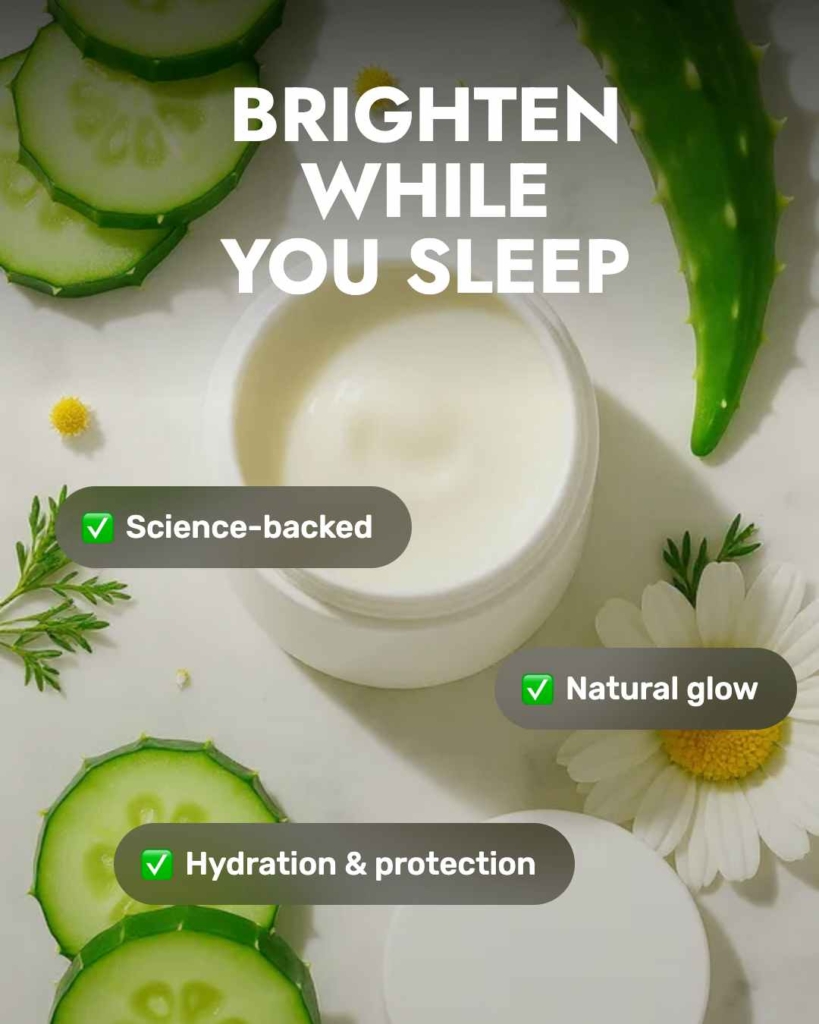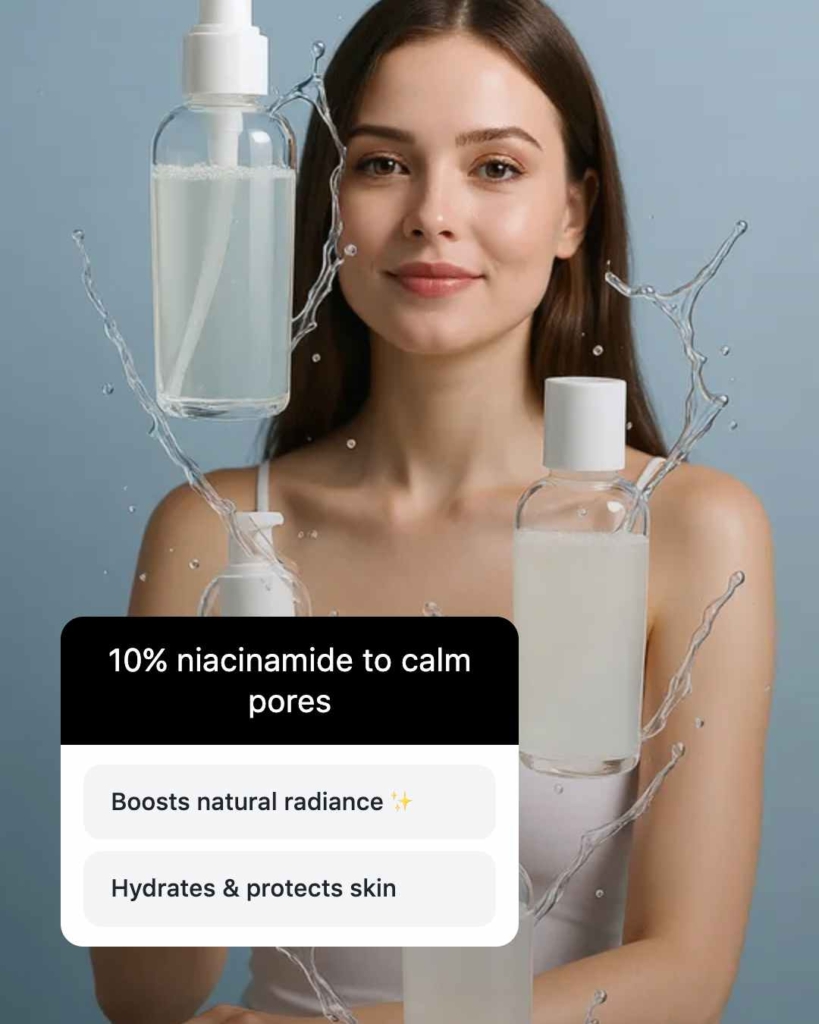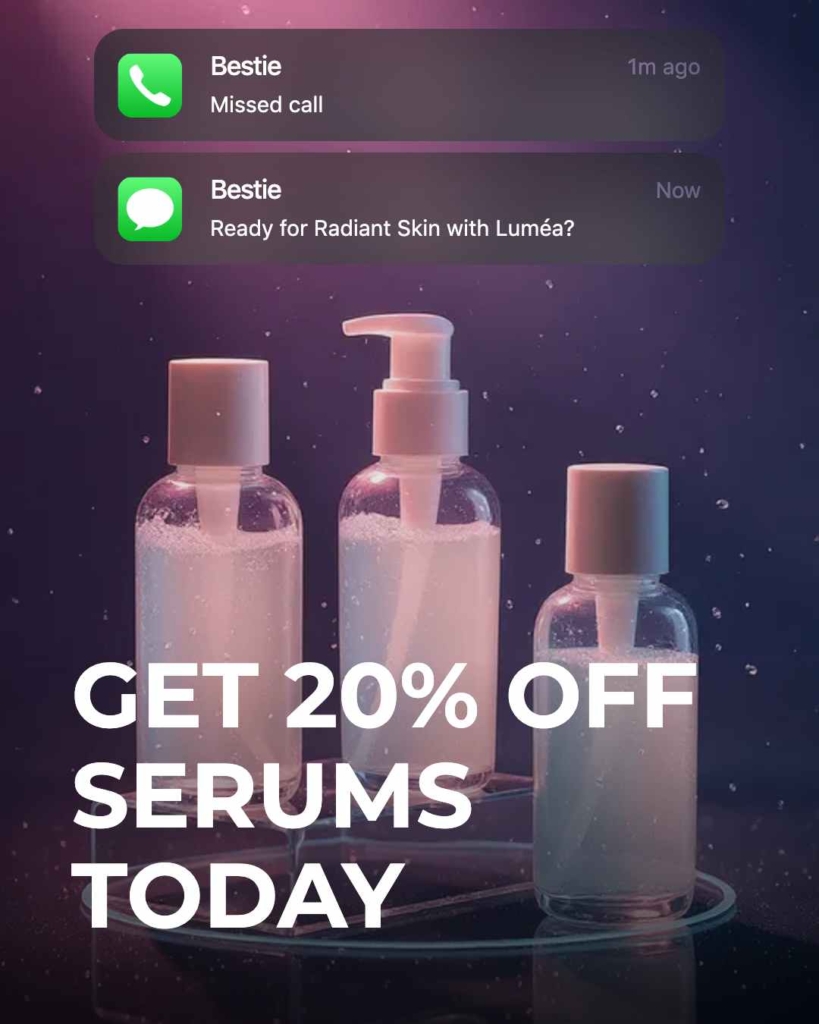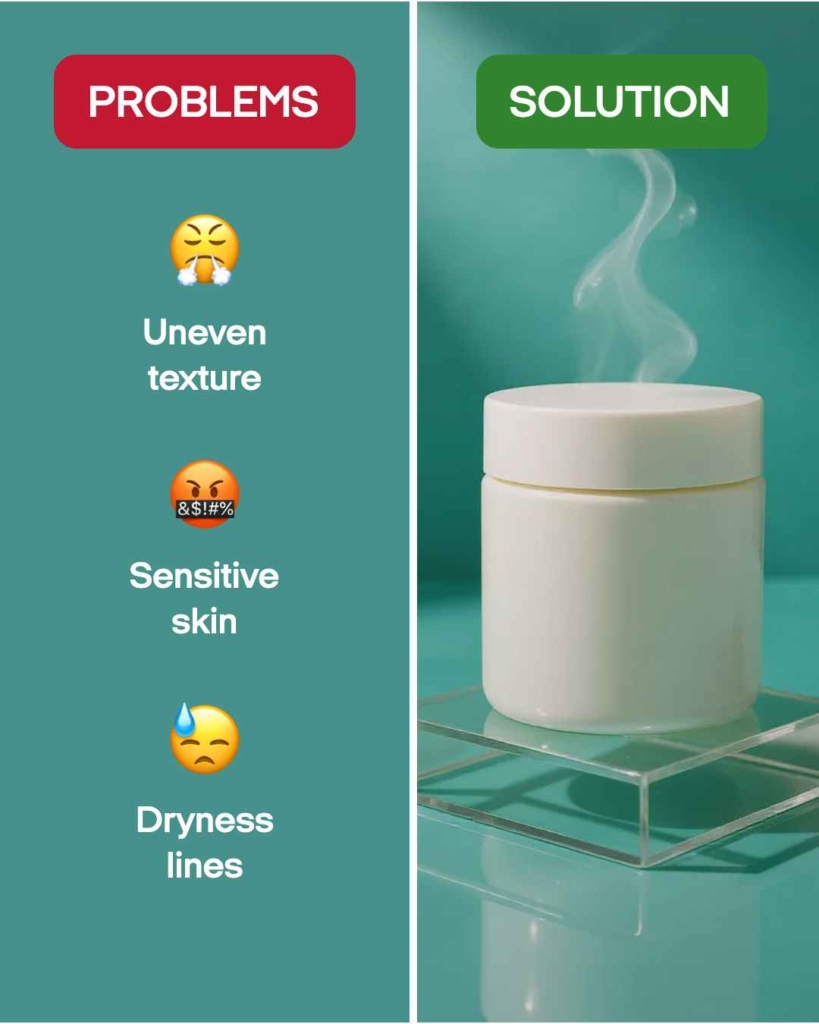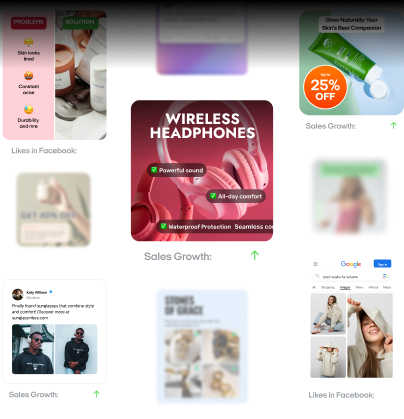How to create skincare ads that convert and buyers will click: Proven ad hacks guide for 2025
Want your skincare ads to stop the scroll and drive real sales? Discover Zeely AI’s proven 2025 ad hacks for creating skincare campaigns that convert, from irresistible visuals to smart targeting that understands what today’s beauty buyers crave.
If your skincare ad looks like everything else in the feed, you’re just paying to get ignored. Creative ads are what change that. They build trust, grab attention, and help you get more customers without burning your budget. When done right, they turn a fast scroll into a curious click.
Why does this matter? Because your audience scrolls past hundreds of beauty posts every single day. To stand out, your ads need more than pretty pictures. You need real skin, honest stories, and proof that your product works. Shoppers want to see ingredients they understand and people they relate to.
If you’ve seen ad spend go up while sales stay flat, you’re not alone. Around 75% of online beauty stores face the same struggle. The problem isn’t that people don’t care, it’s that the ads aren’t cutting through. The answer? Smart, creative skincare marketing that mixes real audience data with bold, story-first campaigns that actually convert.
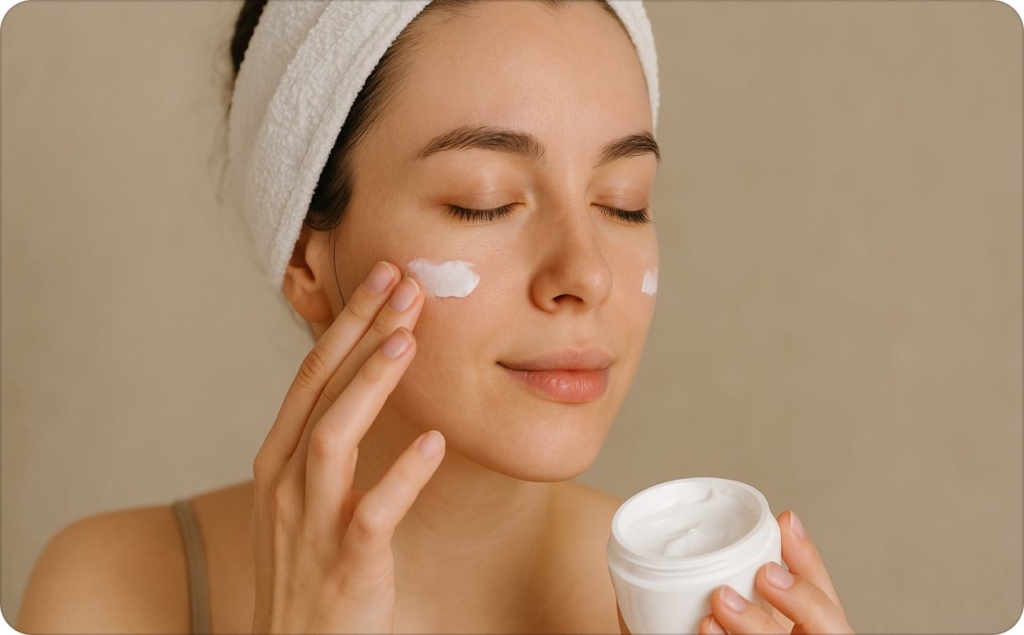
Why effective skincare ads are essential
Beauty is the most crowded corner of social media, yet it’s also where the money flows: social commerce drove 22% of all global beauty sales in 2024. In this race for attention, digital marketing for skincare ads must do more than look pretty. It needs to engage shoppers, demonstrate brand value, and drive conversions.
The role of skincare ads in today’s digital landscape
Skincare discovery now starts with TikTok, Instagram, and a friend’s repost on Facebook. The old way, like glossy pages and celebrity ads, doesn’t work like it used to. Now, one great idea can show up on every feed, picked up by algorithms and shown to the right people at the right time.
And the ad doesn’t need to yell. It just needs to land in the right order: a close-up texture shot to stop the scroll, a simple line that explains the benefit, and a clear call to action like “Try it free today.” That’s what works. The easier it is to follow, the faster they’ll click.
Add some urgency, for example “only 24 hours,” “limited restock,” and you turn attention into action. The brands that test and tweak this formula don’t just get likes. They get results.
We’re talking click-through rates over 2.5%, cost-per-acquisition under $4, returns that beat 3x. These aren’t guesses. They’re goals. Because today, performance matters more than pretty.
You’re not just putting content out there. You’re watching what works. You double down on the best ads, cut the ones that don’t.
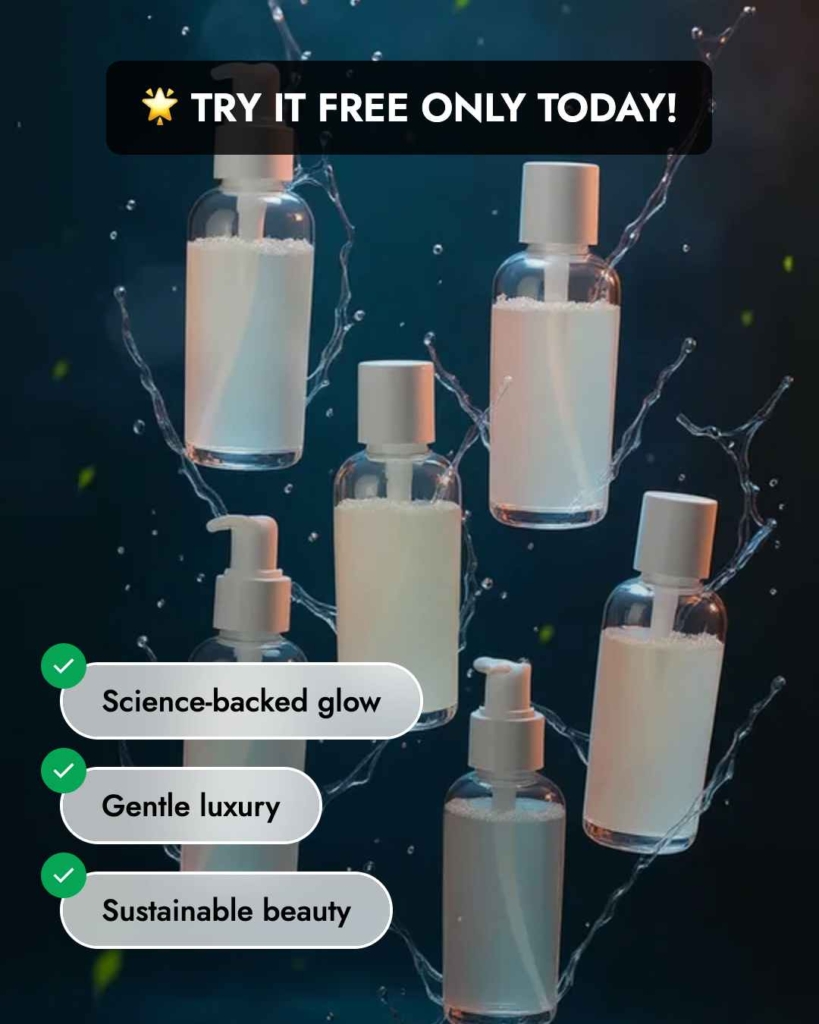
Consumer trends shaping skincare advertising
Today’s shoppers stop for what feels real. A bare face in soft morning light, fingers gently pressing serum into textured skin. When 86% say they buy from brands that feel honest, the message is simple: real wins.
It’s not the perfect glow that grabs attention. It’s the real texture. The calm tone. A quick mention of “niacinamide,” and no fancy words needed. And when the face is someone they already follow? It doesn’t feel like an ad. It feels like a friend sharing what works.
That’s why almost 80% of TikTok Shop beauty sales come from creators, not brands. These aren’t actors. They’re real people showing real routines, and that makes all the difference.
The best skincare ads don’t just explain. They connect. They use natural light, real skin tones, and honest close-ups that show what skin actually looks like. A clear headline or one swipe of serum can stop the scroll faster than a polished slogan ever could.
You let real people share their stories. Then you let the comments, shares, and stitch replies prove your point. That’s not just smart content, that’s trust in action.
When your ad sounds like your audience, you don’t have to push. They lean in on their own.
Key elements of high-performing skincare ads
Ever feel like your ad should have worked, but didn’t? The visuals were great. The product works. The budget was solid. But the clicks didn’t come. And the sales didn’t follow.
That’s not just frustrating. It’s costly.
The truth? Most skincare ads don’t miss because the product is bad. They miss because something important is missing, like the right message, the right visuals, or the right story for the right person.
In this section, you’ll learn how to fix that. You’ll see how to talk to the right audience, show your product in a real, honest way, and tell a story that gets people to take action.
How to align audience targeting and messaging
Most skincare ads miss because they try to speak to everyone at once. But today’s shoppers expect more. In fact, 71% want content that feels like it was made just for them, and they’re far more likely to buy from brands that get that right.
Start by knowing who you’re really talking to. Use tools like Meta Audience Insights, TikTok analytics, and Shopify order data to understand what your actual customers care about. Look at their age, skin concerns, and purchase triggers. Then group those insights into two or three clear audience types so your ad budget hits where it matters.
Next, break your audience into segments that actually make sense. Think by age, skincare needs, lifestyle, and habits. Segment based on reality, not just demographics, but behavior. Think about:
- Gen Z: Looking for fast fixes for acne
- Millennials: Want brightening serums that work into busy mornings
- 40+ shoppers: Need repair and deep hydration that works overnight
Now craft messaging that fits each group. One benefit, one promise, one voice:
- “Clear skin in 7 days with no filters.”
- “Brighten while you commute.”
- “Repair overnight. Wake up refreshed.”
Run two versions of each ad for a week. Measure what matters: click-through rate, cost per click, and cost per action. A high-performing skincare ad typically hits a 1.5 – 2% CTR with a CPC under $2. Let the lowest CPA decide where your spend goes.
When you speak to the right person with the right message, your ad doesn’t just show up, it resonates. You’ve nailed the voice. Now it’s time to match that energy visually.
How to provide visual elements and creative formats
High-quality visuals paired with the right format are the fastest way to lift engagement in skincare ads. Polished studio shots often fail because they look like every other ad. A jar floating on a pastel backdrop feels staged and forgettable. Swap that for a close-up swipe of cream on real skin; viewers trust texture they can almost feel.
Focus on visuals that feel real and premium. Use daylight, macro angles, and true-to-color tones. Show droplets of niacinamide or foam-to-milk transitions. These sensory details show the product works without needing a word.
Weave visual storytelling into every frame. Start bold, reveal the skin concern, and end with one clear CTA. Keep captions on screen so even silent scrollers get the message, like:
- “Glass skin in 7 nights”
- “Brighten while you sleep”
Test and learn with intention. Change one element at a time: background color, camera angle, or headline, and track how it affects performance. Look at watch-time, CTR, and saves.
Check results weekly:
- If engagement lifts 5% or more, scale spend
- If it drops, pivot fast
Design visuals, shape formats, and use imagery to drive performance. Now that your creative earns attention, let’s define the message that keeps it.
How to offer unique selling proposition and emotional appeal
A strong skincare USP blends one clear benefit with a feeling your customer connects to fast. Without that emotional hook, even the best product gets lost in the feed.
Start simple. Choose one powerful feature, like “10% niacinamide to calm pores,” and pair it with a vivid result “Baby-smooth skin in seven days.” That combo builds instant trust.
Bring the promise to life with a real moment. Maybe it’s a teen calming redness before prom. Or a dad ditching razor burn before date night. Quick, relatable scenes turn product facts into emotional proof.
Support the story with trust signals that matter:
- A quote from a dermatologist
- A stat from a two-week clinical trial
- A user testimonial paired with a real-skin selfie
These cues don’t sell, they reassure.
Use clean, direct language. Ditch the fluff. Say “skin-safe,” not “dermatological superiority.” Use verbs like soothe, brighten, repair. One promise. One feeling. That’s enough.
Structure your message for flow and clarity according to Problem → Solution → Transformation:
- Headline: “From breakouts to bare-faced confidence”
- Caption: “Redness down in one week”
- Visual: close-up of real skin or a happy post-use photo
Test two creative angles: one rooted in emotion, like confidence, the other in science, like clinical proof. Run both for a week and track:
- Saves
- Click-throughs
- Cost per action
If you see a 5% lift or 20% CPA drop, double down.
Define your USP. Anchor it in emotion. Shape it with a story. When all three click into place, your ad doesn’t just show up, it sticks.
How to adjust calls to action and conversion tactics
If you’re using generic phrases like “Learn more” or “Shop now,” you’re not giving your audience a reason to act. A study revealed that ads with clear, benefit-driven CTAs drive up to 45% more conversions. That’s a huge gain for a small tweak.
Start by aligning your CTA with your campaign objective. Not every ad should say “Buy now.”
- At the top of the funnel use soft CTAs like “Learn more” or “Explore your routine” to drive engagement.
- For mid-funnel, where trust is building, prompt interaction with “Try a free sample” or “Reveal your glow — get your trial.”
- At the bottom, it’s time for action: “Get 20% off serums today” or “Buy now — ships free.”
Here’s how one clean beauty brand did it: they swapped “Order now” with “Get your free hydrating sample” and saw a 32% lift in CTR within one week. When users saw value and urgency together, they clicked.
Place your CTA prominently: in the first few seconds of video ads, on the second frame of carousels, or directly under texture-rich visuals. Highlight it with bold font, contrasting color, and simple language.
Always test two CTA versions: one urgency-driven, one benefit-led. Track your metrics, like CTR, CPA, and ROAS. If your CTR is below 2% or CPA is rising, tweak and retest.
How to make the most of channel and placement opportunities
Each ad channel behaves differently, from how users scroll to what they expect to see. If your skincare creative doesn’t match the format or the feed, performance drops no matter how strong your message.
Instagram is built for short, visual-first storytelling. Use Reels and Stories for:
- 15-second texture shots
- Before-and-after testimonials
- Quick skincare routines
Vertical formats like these grab attention fast and drive taps, saves, and shares.
Facebook still matters, especially for reach and retargeting. Meta’s ad tools let you get precise upsell product bundles, promote loyalty offers, or remind past customers to come back. It’s not flashy, but it’s powerful when optimized.
TikTok thrives on honesty. Creator-led content and native-style videos work best. Skip the studio polish, go raw, voiceover-driven, or trend-aligned. TikTok Shop alone drove $1.34 billion in U.S. beauty sales last year. The takeaway: blend in to stand out.
Pinterest is your sleeper channel. It’s where planners, DIYers, and seasonal shoppers browse before they buy. Lean into mood boards, routine how-tos, seasonal pins like “Winter skincare” or “Hydration must-haves”.
It’s slow-burn, low-CPC, and ideal for long-tail conversion plays. Choose your channel based on content strength, user behavior, and placement fit. The same idea won’t perform everywhere, but with the right format, it will scale.
Creative examples from top skincare brands
Facebook ad case studies and multi-channel success stories
Cerave: Simplicity that scales
CeraVe leaned into carousel ads to highlight what makes their products clinically trusted. Each slide focused on a single benefit like hydration, barrier repair, or dermatologist backing, paired with close-up textures on real skin. No filters. No fluff. The CTA was simple: “See why dermatologists recommend us.”
Instead of a polished celebrity campaign, they delivered straight product value which is direct and believable. The campaign delivered a 22% higher click-through rate than previous static ads and a sales lift that pushed CeraVe’s Moisturizing Cream into Amazon’s top five bestsellers.
It worked because of the format and focus:
- Clean visuals
- Specific benefit claims
- A structure that gave each message space to land
CeraVe didn’t try to over-explain. They let their product and the skin it helps do the talking.
The Ordinary: Transparency wins clicks
The Ordinary leaned fully into its ingredient-first identity with a clean, 10-second video ad for its niacinamide serum. A dropper releases the product onto bare skin while simple text overlays read: “10% niacinamide. Zero fluff.” Then: “Real results.” The CTA? “Learn what’s inside.”
No voiceover. No music. Just motion and clarity. For a brand rooted in clinical minimalism, silence became its most effective tool. The campaign delivered a 38% increase in click-through rate and 42% rise in landing page time-on-site.
Minimal content. Maximum impact.
If your product is built on purity, trust, or science-first positioning, take note:
- Show ingredients up close in motion, not just the bottle
- Let visual clarity carry the claim
- Back performance with real, observable results, not just ad copy
When you focus on what matters, the formula and the benefit, even the quietest ad becomes the loudest in the scroll.
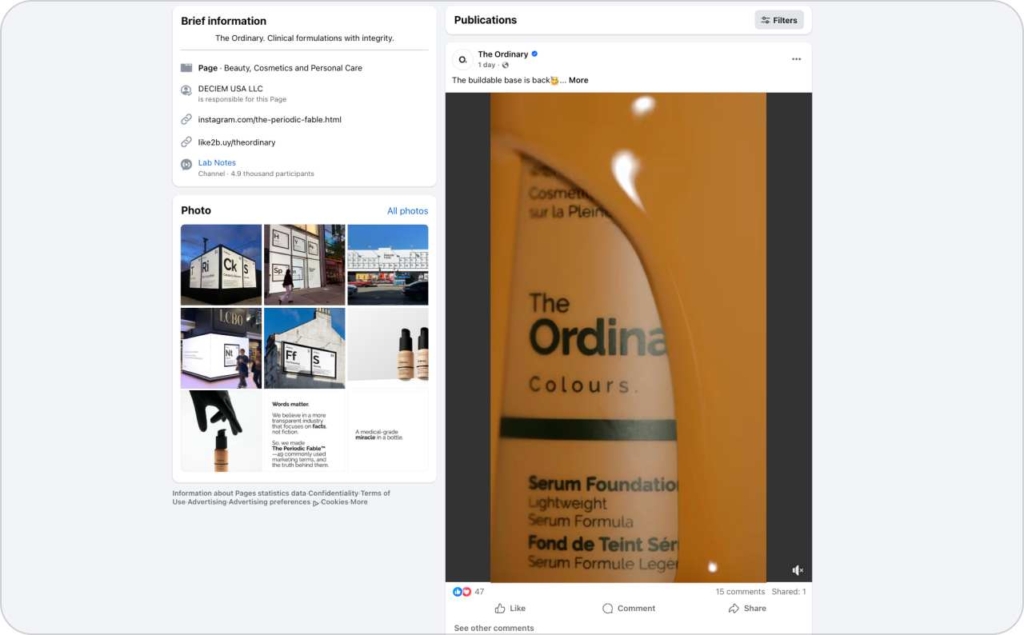
Photo source: The Ordinary on Facebook
Olay: Personalization that converts
Olay shifted away from standard product promos by spotlighting their AI-powered Skin Advisor quiz — a tool that builds custom skincare routines based on a quick face scan. The Facebook video led with a pointed question: “Your skin isn’t generic. Why is your routine?”
Viewers watched real users go through the scan and receive personalized product recommendations. The CTA: “Get your custom routine.” Afterward, Olay followed up with retargeted carousels showing individualized bundles based on quiz results. The campaign delivered 28% lower cost per acquisition compared to static catalog ads and 35% increase in quiz completions.
Why it worked:
- Interactive tool = user investment
- Personalized messaging = relevance
- Retargeted follow-up = momentum that converts
Olay made the experience feel specific — not just the product, but the entire funnel. When personalization goes beyond the headline and into the flow, performance follows.
Fenty Beauty: From TikTok to Facebook
Fenty repurposed native TikTok GRWM content directly into Facebook Reels. The visuals were raw, diverse, and authentic — exactly what performs best in beauty today. Instead of retouching, Fenty celebrated pores, routines, and relatable creators.
That content, distributed as-is across Facebook and Instagram, delivered a 21% lift in ad recall and a 27% spike in engagement among mobile-first Gen Z audiences.
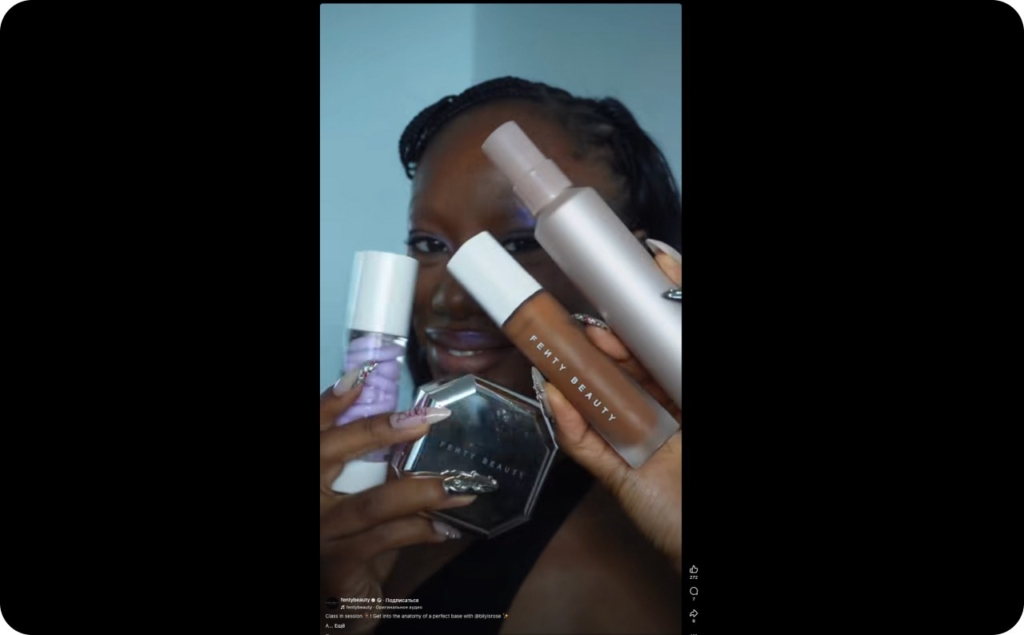
Photo source: Fenty Beauty on Facebook
How to create your own standout skincare ads
Effective skincare ads begin with behavior-based data, not moodboards. Creative that converts is built on observed actions, and not assumptions. Skincare advertising fails when it ignores real-world signals from users.
Use Meta Audience Insights and TikTok Creator Center to extract first-party data. Identify demographic clusters tied to skincare concerns: oily skin in Gen Z, hyperpigmentation in Millennials, or elasticity loss in Boomers. Pair this with platform behavior insights to map audience segments to product categories.
Go deeper with proprietary data. Shopify order timelines, Google Analytics geolocation reports, and heatmaps reveal hidden behavioral triggers. Spot spikes in purchases after 8 PM? That’s your cue for night-time routines. See an uptick in hydrating serum sales post-winter? That’s seasonality influencing skincare cycles.
Build distinct buyer personas around intent. Each one should combine demographics, problem-solution needs, and desired outcomes:
- Gen Z → fast-acting acne solutions + influencer-backed credibility
- Millennials → hybrid serums for glow + productivity messaging
- Boomers → barrier-repair formulas + expert clinical validation
Conduct a comparative audit. Analyze ads from category leaders like The Ordinary, Cocokind, and Hero Cosmetics. Log ad formats, emotional hooks, and creative pacing. Run a visual LSI scan: how often do blue hues, droppers, or minimal text overlays show up? These patterns shape expectations.
Extract voice-of-customer directly from the platforms. Tools like Brandwatch and CommentPicker surface authentic user language. Collect pain points, unmet expectations, and praise phrased in the audience’s own words. These inputs craft emotionally resonant hooks grounded in linguistic proximity.
Frame your creative development process as a repeatable chain:
Audience Insight → Persona → Messaging Angle → Ad Format → Offer Stack.
This structure transforms abstract ideas into focused, high-performing ad concepts.
Test, track and optimize performance
Start with A/B testing. Change one variable at a time: headline, CTA, visual angle, or format. For example, test “Buy now” versus “Get your free sample.” Keep each test live for 5 – 7 days with at least 1,000 impressions for statistically valid insights.
| Performance metric | Target/Goal | Purpose | Example |
| CTR — Click-Through Rate | 1.5% – 2% | Scale how compelling the ad is | “Wake up dewy” outperformed “Hydrate overnight” — CTR increased by 22% |
| CPA — Cost Per Action | Under $2 | Monitor efficiency of acquisition | Same test: CPA dropped by 18% when using “Wake up dewy” |
| ROAS — Return on Ad Spend | 3x+ | Evaluate campaign profitability | A retargeting video ad with a timed promo delivered 3.4x ROAS |
Use tools like Meta Ads Manager, TikTok Ads Dashboard, and GA4 to slice results by age, device, and platform. That tells you where your creative resonates best and where spend should follow.
Don’t stop with CTR. Track engagement cues like saves, shares, and comment sentiment. These qualitative signals often predict which creatives will scale.
Finally, build a rhythm: test → learn → refine → retest. Every new skincare ad you launch should be smarter than the last.
Make skincare ads with AI ad generator
In beauty, first impressions matter. Whether you’re launching a new product line, running a seasonal campaign, or scaling your ecommerce skincare brand, Zeely helps you create polished, high-converting ads in minutes, no creative agency, no heavy tools.
From serums to skincare sets, build stunning visuals and videos that show off your products, highlight benefits, and drive real results across every platform.
You may also like
Why it works for skincare brands
- Create beautiful ads fast. Design static images in seconds and product videos in under 7 minutes with a rapid ad creation
- Turn curiosity into conversions. Launch campaigns that speak to skincare buyers — from self-care seekers to beauty obsessives
- Stay consistent, stay on-brand. No need for expensive shoots or freelancers. Create everything in-house with control over tone, style, and visuals
- Reach beauty lovers everywhere. Publish platform-perfect content for Instagram, Facebook, TikTok, YouTube, and Google Shopping
- Test what resonates. Experiment with different visuals, messages, and formats by generating up to 20 ad variations per product
What’s inside for beauty and skincare marketing
- Templates made for skincare. Choose from 100+ layouts designed for serums, moisturizers, acne treatments, routines, bundles, and more
- Effortless product messaging. Instantly write clean, benefits-driven headlines and product blurbs that highlight ingredients, results, and glow-up potential
- Lifelike video presenters. Add personality to your videos with diverse virtual models — great for testimonials, tutorials, or how-to content
- Visual editing that matches your aesthetic. Adjust colors, remove backgrounds, and crop product photos to maintain a sleek, premium look
- Launch ads directly to your channels. Connect to Facebook and Instagram and publish instantly — no need to switch platforms or reformat
- Tell your skincare story. Use storytelling prompts to build short videos that walk customers through your brand’s mission, values, or product journey.
Made to support brand growth
Whether you’re a new skincare startup or an established label expanding your product range, Zeely helps you build high-quality campaigns on your own terms. Plans start at $29.95/month, with more visuals, videos, and templates included as you scale.
Why skincare brands choose Zeely
Today’s customers expect beauty to be visual, authentic, and polished. Zeely helps you deliver just that without hiring a creative team or spending weeks in production. From clean beauty to clinical-grade skincare, you can turn your products into scroll-stopping campaigns that boost your presence and drive sales.
Conclusion and next steps: From inspiration to execution
From real-skin visuals to performance-tested messaging, you now have a toolkit to craft skincare ads that resonate, convert, and scale. You’ve learned how to define audience personas, source authentic content, shape emotional USPs, and fine-tune CTAs across platforms like Instagram, TikTok, and Pinterest.
Now it’s time to act.
Start small. Choose one high-potential audience segment. Build one ad variant that reflects their real concerns and aspirations. Test it. Track the results. Learn fast. Whether you’re optimizing for ROAS or building long-term engagement, your next campaign should be built with intention.
Ready to create skincare ads that actually convert? Use this guide and start optimizing your next campaign today.
You may also like
Also recommended




